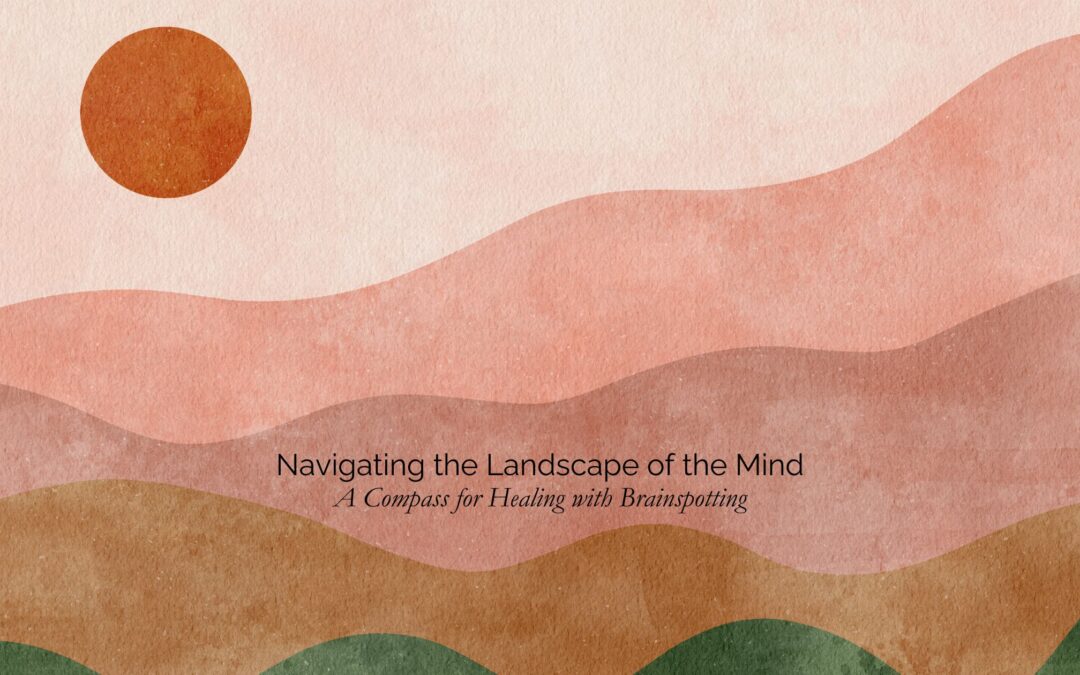Picture your mind like a vast and intricate landscape, with hidden valleys where difficult emotions cast long shadows and towering peaks where your highest potential is within reach. Brainspotting is like a compass in this internal expedition, guiding you through the uncharted territories of your psyche to find healing and peace.
 In the diverse world of therapeutic modalities, Brainspotting emerges as a profound and innovative approach, offering significant relief and healing for individuals grappling with various psychological and physical challenges. Developed by Dr. David Grand in 2003, Brainspotting is a powerful, focused treatment method designed to help individuals access, process, and overcome trauma, emotional and bodily pain, and a spectrum of psychological issues. This technique uses specific points in a client’s visual field to access unprocessed trauma in the subcortical brain. By maintaining focus on a fixed spot, clients can tap into the deep-seated areas of the brain where stress and trauma are stored. This focus facilitates a direct and powerful connection to the autonomic and limbic systems, often inaccessible through traditional talk therapy alone.
In the diverse world of therapeutic modalities, Brainspotting emerges as a profound and innovative approach, offering significant relief and healing for individuals grappling with various psychological and physical challenges. Developed by Dr. David Grand in 2003, Brainspotting is a powerful, focused treatment method designed to help individuals access, process, and overcome trauma, emotional and bodily pain, and a spectrum of psychological issues. This technique uses specific points in a client’s visual field to access unprocessed trauma in the subcortical brain. By maintaining focus on a fixed spot, clients can tap into the deep-seated areas of the brain where stress and trauma are stored. This focus facilitates a direct and powerful connection to the autonomic and limbic systems, often inaccessible through traditional talk therapy alone.
What is Brainspotting used for?
Imagine Brainspotting as your trusted guide, offering a map to the tucked-away parts of your brain that traditional therapies might not reach. Born from the discovery that “where you look affects how you feel,” this method points to specific spots in your visual field that can unlock deeply stored emotional distress. Holding your gaze on these spots, you can connect with the brain’s natural healing processes, often leading to profound emotional breakthroughs.
Just as a compass works in any environment, brainspotting’s versatility helps navigate multiple emotional terrains and can be used to support healing from:
- PTSD: For those who have experienced trauma, Brainspotting provides a gentle yet effective approach to processing trauma responses that are locked in the brain’s non-verbal, non-cognitive areas.
- Anxiety and depression: Brainspotting can pinpoint and process the underlying causes of anxiety and depression. It helps unravel the neural network of emotions, aiding individuals in overcoming overwhelming feelings and restoring emotional balance.
- Physical Pain: Physical ailments are often intertwined with emotional distress.
Brainspotting addresses the psychosomatic connection by identifying and healing the emotional component of physical pain, which can lead to significant relief and improved physical well-being.
- Performance Anxiety: From athletes to public speakers, individuals facing performance anxiety can find Brainspotting beneficial. It helps identify and work through the specific brain spots that activate this anxiety, enhancing performance by reducing stress and increasing focus.
Fast-Tracking the Healing Journey
 Brainspotting is not just about guiding the journey; it’s about making the trek more efficient. Brainspotting often leads to faster healing than traditional therapies because it bypasses the more guarded cognitive pathways and goes straight to the emotional core. Clients frequently report significant shifts after just a few sessions. During a Brainspotting session, therapists help clients locate the physical sensations associated with various emotions and identify the eye positions corresponding to these feelings. By maintaining focus on these “brainspots,” clients can engage with the traumatic memories and emotions underpinning their shame.
Brainspotting is not just about guiding the journey; it’s about making the trek more efficient. Brainspotting often leads to faster healing than traditional therapies because it bypasses the more guarded cognitive pathways and goes straight to the emotional core. Clients frequently report significant shifts after just a few sessions. During a Brainspotting session, therapists help clients locate the physical sensations associated with various emotions and identify the eye positions corresponding to these feelings. By maintaining focus on these “brainspots,” clients can engage with the traumatic memories and emotions underpinning their shame.
Bilateral sound often accompanies focus, which enhances the brain’s ability to process and integrate traumatic memories. As the brain accesses and processes these deep-seated emotions, clients often experience a significant shift in their feelings. They report a decrease in distress and an increase in emotional relief and understanding. This direct processing can lead to profound self-perception and emotional health changes, fostering a greater sense of self-compassion and resilience.
Choosing Your Path with Brainspotting
If you’re standing at a crossroads, looking for the right path toward healing, consider Brainspotting. As an effective intervention, Brainspotting in the context of therapy can help you navigate the complex geography of your emotions and memories. Whether you’re looking to heal from past wounds, overcome current challenges, or simply want to trek towards the highest version of yourself, Brainspotting could be the guide you need.
Photo Credits:
Photo by John Fowler on Unsplash
Photo by Justin Roy on Unsplash




